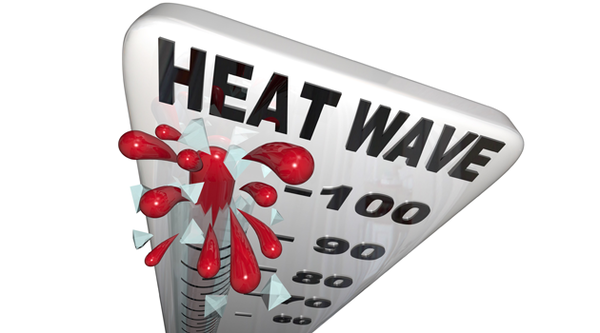Hot summer months pose special hazards for being outdoor. Labor-intense activities in hot weather can raise body temperatures beyond the level that normally can be cooled by sweating. Heat illness initially may manifest itself as heat rash or heat cramps, but can quickly escalate to heat exhaustion and then heat stroke if simple preventative measures are not followed.
 |
People can be subject to heat stress in a variety of settings, You should educate yourself on how to protect yourself when working in the heat.
What are Heat Illnesses?
Symptoms Include:
Response:
Heat Cramps:
• Muscle cramps
• Pain, or spasms in the abdomen, arms or legs
• Excessive sweating.
• Call EMS (or 911 as appropriate) for medical attention.
• Until first responders arrive, follow these steps:
0 Stop all activity, and sit in a cool place.
0 Drink clear juice or a sports beverage, or drink water with food–avoid salt tablets.
0 Cool the person by sponging with water and providing moving air. Don’t cool too much – stop cooling if the employee starts to shiver.
0 Do not return to strenuous work for a few hours after the cramps subside.
0 Seek further medical attention if you have the following: heart problems, are on a low-sodium diet, or if the cramps do not subside within one hour.
Heat Exhaustion:
• Fast, shallow breathing
• Weak, rapid pulse
• Cool, pale clammy skin
• Heavy sweating
• Weakness, fatigue and dizziness
• Headache, nausea/vomiting
• Fainting
• Muscle cramps
• Call 911 as appropriate for medical attention.
• Until first responders arrive, follow these steps:
0 Move the person to a cooler environment. If possible, lay the person down and loosen tight fitting clothing.
0 Cool the person by sponging with water and providing moving air. Don’t cool too much – stop cooling if the person starts to shiver.
0 If the person is fully alert and not nauseous, provide cool water or other non-alcoholic and caffeine free beverages.
Heat Stroke:
• Hot, dry, flushed skin
• Absence of sweating
• Agitation, confusion
• Decreased level of consciousness
• Throbbing headache
• Nausea and vomiting
• Seizures
• Increased respiratory rate
• Irregular pulse rate
• Shock
• Call 911 for medical attention.
• Until first responders arrive, follow these steps:
0 Maintain airway, breathing and circulation as required.
0 Move the person to the coolest place available.
0 Lay the person down supine (on the back) unless the person is actively vomiting or having a seizure. If this is the case, place them on their side.
0 Remove outer clothing and apply cold water to the person by either dousing or applying wet, cool sheets. Spraying, sponging and fanning may be used also.
0 If the person is alert, provide cool water or other nonalcoholic and caffeine free beverages.
Preventing Heat Illness:
Educate
• About the hazards leading to heat illnesses and how to prevent them
• How to recognize symptoms
• To immediately report symptoms
• To know how to tell if they are properly hydrated (see hydration chart)
• About proper clothing (e.g. clothing that allows for dissipation of sweat, the difference between cotton and lightweight blends)
Water
• Keep fresh water close to you at all times
• Frequently drink small amounts of water (about 1 cup every 15 – 20 minutes)
• Ensure water is available when in remote areas
Rest In Shade
• Limit your activity when temperatures are high
• Take more breaks when performing heavier work in high heat and humidity
• Schedule frequent rest periods with water breaks in shaded or air-conditioned areas
Monitor
• Weather reports daily
• Work activity. Set up a buddy system when possible
• Ensure you are drinking water, resting in shaded areas
• Symptoms to ensure people are not showing signs of heat related illness
Do:
• Drink fluids, even if you are not thirsty
• Wear loose clothing
• Utilize shade
• Move slowly
• Take frequent breaks in well ventilated areas
• Use a wet paper towel on your face or other hot spots
• Avoid overexertion
• Acclimatize – gradually expose your body to heat and work
• Remind others to drink water
Don’t:
• Drink ice cold drinks
• Take salt tablets (unless doctor prescribed)
• Skimp on water
• Drink caffeine, alcohol or sugared sodas
• Exceed 1.5 quarts of fluid in an hour
• Don’t exceed 12 quarts of fluid in a day
For additional information:
OSHA Heat Illness Prevention Page: https://www . osha . gov/SLTC/heati llness/index.html CDC NIOSH Extreme Heat Page: http://www .cdc.gov/niosh/topics/heatstress/
National Weathe r Service Heat Safety Page: http://www .nws.noaa.gov/os/heat/